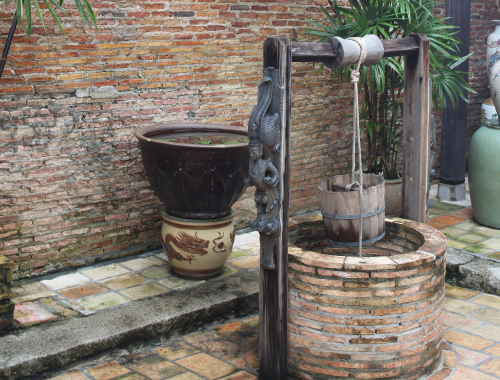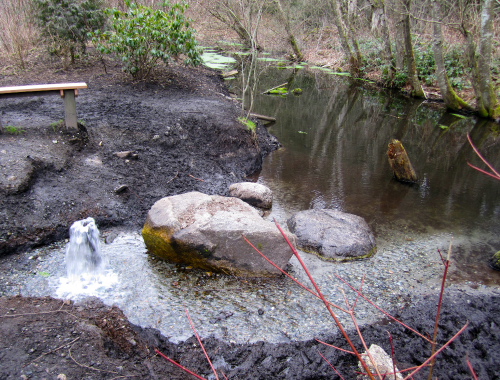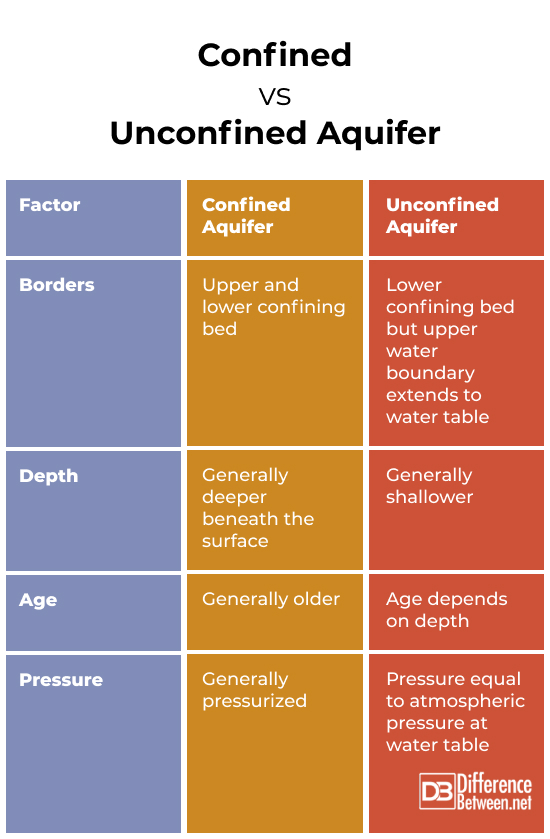Difference Between Confined and Unconfined Aquifer

Confined Aquifer
A confined aquifer is where a body of ground water exists within permeable rock, such as sandstone, with impermeable or poorly permeable layers surrounding it. The layers confining it are often composed of relatively impermeable rock, such as shale, or impermeable sediments such as clays. A confined aquifer can be replenished by rainwater that flows into the aquifer from an opening between the confining layers. The water in confined aquifers can be thousands of years old. The groundwater in some confined aquifers is under pressure. As a result, if a borehole is dug through the impermeable layer of the aquifer to the permeable layer beneath, water will actually flow up through the borehole. This is the physical basis for artesian wells.
Advantage of a confined aquifer
Since they are usually deeper beneath Earth’s surface, confined aquifers are less affected by surface conditions, such as droughts.

Unconfined Aquifer
An unconfined aquifer is where pressure at the upper water boundary is at atmospheric pressure. For this reason, unconfined aquifers tend to be closer to Earth’s surface. They are also able to rise and fall in terms of their proximity to Earth’s surface based on water supply and precipitation. Unconfined aquifers are also called water table aquifers. This is because the upper water surface of an unconfined aquifer, where water pressure equals atmospheric pressure, is called the water table. Where the water table and Earth’s surface intersect, there will be springs, lakes, rivers, and other surface bodies of water. The unconfined aquifer will be bounded beneath by an impermeable consolidated rock layer.
What is the difference between an unconfined aquifer and an artesian aquifer?
An artesian aquifer is an aquifer where the groundwater is under pressure because of being compressed between two confining beds. If a borehole is made in the upper impermeable confining bed so that the borehole reaches the permeable rock layer, the pressurized water in the permeable layer will flow upwards towards the Earth’s surface. In an unconfined aquifer, the water table has a water pressure of 1 bar (atmospheric pressure). As a result, water will not flow upwards since the water pressure and atmospheric pressure will be equal and cancel each other out.
What is an example of an unconfined aquifer?
Unconfined aquifers can be found wherever a body of water is present at the land surface. This includes river valleys and lakes.
What is the disadvantage of an unconfined aquifer?
Because of being generally closer to the land surface, an unconfined aquifer will be more susceptible to drought conditions.
What is the advantage of an unconfined aquifer?
Because unconfined aquifers are usually near the surface, they will generally not take very long to be recharged if there is sufficient rain.
Similarities between a confined and unconfined aquifer
Confined and unconfined aquifers both involve groundwater moving between the pore-space in rock. They are also both important sources of water and more water is contained in aquifers than in rivers or lakes.
Differences between a confined and unconfined aquifer
What is the difference between the two types of aquifers?
Although there are interesting similarities between a confined and unconfined aquifer, there are also important differences. These differences include the following.
- Confined aquifers will be confined by two impermeable beds of material, one above and one below, whereas unconfined aquifers will be confined by only one impermeable bed below and extend to the zone where water pressure equals atmospheric pressure (the water table).
- Confined aquifers can be very deep below the the surface and can have water reserves that are thousands of years old, whereas unconfined aquifers will generally be closer to the surface and the water is generally younger except for the deepest parts of the unconfined aquifer.
- Confined aquifers will often be pressurized, allowing for artesian wells, whereas unconfined aquifers will have water pressure equal to atmospheric pressure at their upper water boundary.
Which one is slower to recharge, a confined or unconfined aquifer?
Recharge may be slower in a confined aquifer because rainwater may have to flow horizontally from a distance to enter the confined aquifer once it has seeped into the ground. For an unconfined aquifer, on the other hand, the rainwater merely has to seep vertically into the ground until it reaches the water table. This may take less time.
Do you get less water from a confined or unconfined aquifer?
Generally, there will be a greater water supply from an unconfined aquifer than a confined aquifer.
Confined vs. unconfined aquifer

Summary
A confined aquifer is where groundwater exists within a permeable rock or soil layer confined by upper and lower beds composed of relatively impermeable rock or soil. The confining beds will often cause the confined aquifer to be under pressure, providing the basis for artesian wells if a borehole is made through the upper confining bed into the permeable layer. Confined aquifers can be very old and are less affected by droughts. An unconfined aquifer is an aquifer where the upper water boundary is at the water table where the water pressure is equal to atmospheric pressure. Where the water table and Earth’s surface intersect, there will be rivers, lakes, and springs. Confined and unconfined aquifers are similar in that they both involve groundwater moving through pore spaces in rock. They are also an important source of fresh water. Confined and unconfined aquifers differ in that confined aquifers have an upper and lower confining bed, are generally older and deeper, and are generally under higher pressure. Unconfined aquifers, on the other hand, are bound by only a lower confining bed of consolidated rock. They are generally younger and shallower. Their upper water boundary is at atmospheric pressure. Also, unconfined aquifers will be more affected by drought conditions. The water table of an unconfined aquifer can be near the surface or deep beneath the surface depending on the level of precipitation.
- Difference Between Environmental Performance Index and Development - November 24, 2023
- Difference Between Environmental Intervention and Development - November 8, 2023
- Difference Between Eco Efficiency and Eco Effectiveness - September 18, 2023
Search DifferenceBetween.net :
Leave a Response
References :
[0]“Aquifers and Groundwater.” U.S. Geological Survey, 16 Oct. 2019, https://www.usgs.gov/special-topics/water-science-school/science/aquifers-and-groundwater.
[1]“Artesian Water and Artesian Wells.” U.S. Geological Survey, 6 June 2018, https://www.usgs.gov/special-topics/water-science-school/science/artesian-water-and-artesian-wells#:~:text=If%20such%20a%20confined%20aquifer,is%20called%20an%20artesian%20aquifer.
[2]“Confined and Unconfined Aquifers.” Department of Natural Resources and Environment Tasmania, n.d., https://nre.tas.gov.au/water/groundwater/aquifers/confined-unconfined-aquifers#:~:text=Unconfined%20aquifers%20are%20usually%20recharged,alluvial%20deposits%20in%20river%20valleys.
[3]“Groundwater Age.” U.S. Geological Survey, 27 Feb. 2019, https://www.usgs.gov/mission-areas/water-resources/science/groundwater-age.
[4]“Groundwater Basics – Aquifer.” Bureau of Reclamation Yuma Area Office, 15 Oct. 2021,https://www.usbr.gov/lc/yuma/programs/YAWMS/GROUNDWATER_aquifer.html#:~:text=Thus%20from%20a%20hydraulic%20standpoint,than%20with%20a%20confined%20aquifer.
[5]“Groundwater: What is Groundwater?” U.S. Geological Survey, 6 Nov. 2018, https://www.usgs.gov/special-topics/water-science-school/science/groundwater-what-groundwater.
[6]King, Hobart M. “Shale.” Geology.com, https://geology.com/rocks/shale.shtml. Accessed 24 March 2023.
[7]“Water Table.” National Geographic Society, 20 May 2022, https://education.nationalgeographic.org/resource/water-table/.
[8]“What is the difference between a confined and an unconfined (water table) aquifer?” U.S. Geological Survey, n.d., https://www.usgs.gov/faqs/what-difference-between-confined-and-unconfined-water-table-aquifer.
[9]Yamanaka, Masaru, and Yoshihiro Kumagai. "Sulfur isotope constraint on the provenance of salinity in a confined aquifer system of the southwestern Nobi Plain, central Japan." Journal of hydrology 325.1-4 (2006): 35-55.
